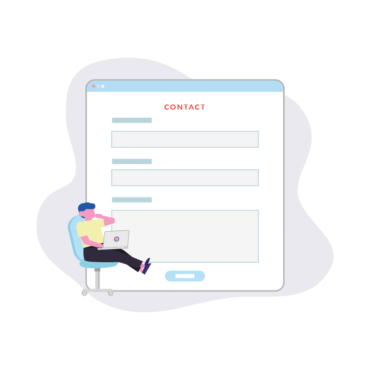Our Programs
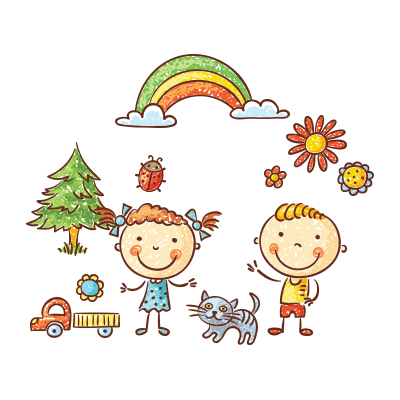

Our Curriculum is an advanced and interactive Montessori method
Our special educational method is a mixture of Education, Learning, Science and fun. The focus of our programs is to stay true to the Montessori method while at the same time utilize all available technologies and media to enhance and expedite the learning experience. Unlike other Montessori schools, our Montessori methods is current to the 21st century. We utilize the Montessori method to its maximum limits and push through by adding components and educational materials that are available now, that weren’t available in the time when Dr. Montessori authored the Montessori Method. As such, our method is a hybrid between the tried and true methods of Dr. Maria Montessori and the tried and true educational methods of the 21st century. Our primary goal is to help the child learn faster so as to enable him or her to excel when they attend elementary school.

The Curriculum
Practical Life
A child finds joy in activities we adults view as work or as everyday routine. Once a child witnesses these activities in “real” life, he wants to model the activities, again and again. Practical Life activities are typically introduced to the child first. The tasks are simple, precise and involve activities that the child has already seen in his home and subsequently wants to mimic.
Practical Life activities prepare a child to be a productive, effective and well functioning person in our world. The work is holistic in developing the child’s “whole self” by honing

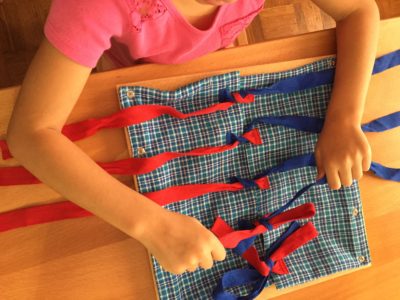
fine motor skills, grace of movement, self-regulation, concentration, to behave with respect and with good manners, independence, and self-esteem. One “ah-ha” that occurred during my training was that Practical Life is not simply about learning how to sweep {care of the environment} or to button a shirt {care of self} but it is much bigger than those goals. Practical life is about preparing a child for life and about developing far less tangible skills, such as self-esteem, completing a cycle of work, self-sufficiency, problem-solving, confidence, and independence, all qualities that will help in life but also later in academic work.
“These exercises also develop an understanding of the process and order involved in a complete cycle of activity with a beginning, a middle and an end. The integration of self and understanding of process that result from these exercises are important for any serious task the child will undertake.” – Montessori: A Modern Approach
For example, these activities indirectly prepare the child for reading and writing. Through Practical Life Activities, the child hones hand-eye coordination and muscle control and executes the tasks left to right and top to bottom preparing him for writing and reading.
Materials within practical life are real in that they are functioning, breakable, and resemble materials we’d see and used in daily life. Montessori did not outline a specific set of Practical Life materials but instead created categories that included what she observed and believed to be the most relevant activities to a child’s life and to a child’s development. Montessori introduced areas including:
- Basic Procedures such as pouring, spooning, tweezing, basting, opening and closing containers, folding napkins.
- Care of Self such as dressing (buttoning, tying, snapping, zippering), hand washing, putting on a coat, sewing, polishing and food preparation.
- Care of the Environment such as table scrubbing, cloth washing, plant watering and dusting.

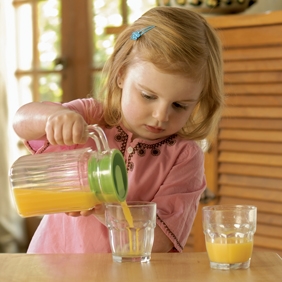
- Grace & Courtesy such as demonstrating good manners with proper greetings and goodbyes, sitting, moving the body, and silence (inner calm & listening)
- Peace based on three levels of learning and awareness: inner self, classroom, and globe
The lead teacher is responsible for creating and arranging her own works to be presented beautifully, neatly and orderly on the shelves based on isolation of difficulty (simple to complex) and indirect preparation. When the lead teacher is demonstrating an activity she must use “economy of words” allowing the child to focus on her movements and not her words. The child must grasp the work in a way that enables him to “teach” it to another person and in a way that is authentic in that he “owns” his version of the exercise.
– Credit: Carrots Are Orange, Montessori Theory & Philosophy
Sensorial (5 Senses)
Sensorial materials are geared toward helping children in the process of creating and organizing their intelligence. Each material is scientifically designed to isolate a quality found in the world such as color, size, shape, etc. The isolation helps focus the attention on this singular aspect. Through repeated manipulation and hands-on experience using sensorial materials, the child is able to form clear ideas about things that could not be explained simply through words. “Our sensorial material provides a kind of guide to observation, for it classifies the impressions that each sense can receive: the colours, notes, noises, forms and sizes, touch-sensations, odors and tastes. This undoubtedly is also a form of culture, for it leads us to pay attention both to ourselves and to our surroundings,” Maria Montessori, in her book, The Absorbent Mind.
Two examples of sensorial activities used in Montessori classrooms are The Pink Tower and The Binomial Cube.
The Pink Tower
This is part of the sensorial area in the Montessori environment. It encompasses 10 pink wooden cubes with sizes ranging from the smallest cube at 1cm cubed to the largest at 10 cm cubed. The cubes increase progressively in the algebraic series of the third power. So the second cube equals 8 of the first while the third cube equals 27 of the first, and so on.
The purpose of The Pink Tower is to assist children in controlling voluntary movement as they place the cubes one on top of the other using a single movement of the hand. This also helps to improve visual-motor coordination. Additionally, the activity provides an introduction to mathematics and provides the child with the opportunity to use visual discrimination to sort the dimensions of the blocks.

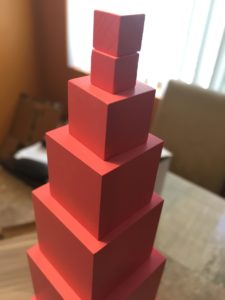
Binomial Cube
Also part of the sensorial category, the Binomial Cube is comprised of a box with one red cube and three red and black matching prisms and one blue cube and three blue and black matching prisms. All the pieces, once assembled, form a cube of a binomial (a+b)3. The square of the binomial is painted on the lid of the box.
The Binomial Cube physically represents a math equation and provides the foundation for the development of later math skills for children such as the cube of a binomial, the cube root, and preparation for the proof of the formula of (a+b)3 at Elementary Level. However, for the ages 2 – 5 years old, the purpose of the material is not to teach math, but instead, to present the child the opportunity to find patterns and relationships. Therefore, the material is presented like a three dimensional puzzle and classified as a sensorial activity. Maria Montessori believed that education is a natural process by which a child learns through experiences in his or her environment rather than through the mere act of listening. Beliefs such as this are what she used in founding the philosophy of a Montessori education and what make up the basis for activities presented in the Montessori environment.

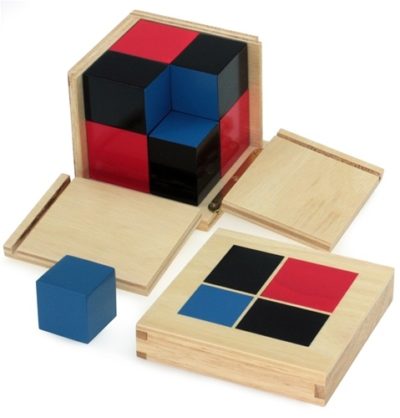
Language
The curriculum for 3-6 year old children is designed to prepare the children for academic life through learning Language (Yellow level, Pink level, Blue level, Green level, Language analysis, Mathematic, Geography, Science, Zoology, and Botany.

In the Language area the main focus will be divided into two levels ( the mechanical stage and writing preparation level, and the sound boxes level) the child will obtain the mechanical stage and writing preparation level that through:-
– Working on the Green boards to give them practice in writing and opportunity to experiment freely writing without a sense of failure.
– Working on the phonetic sounds of the letters of the alphabet through the Sandpaper l Letters to help them gain a muscular memory of the shapes.
– Then the children will work on the Metal Insets to develop the ability to hold a pencil properly and to learn how to have a control while manipulating the pencil to the right, eft, and around. And to develop hand-eye coordination and fine motor control.
– Then working with the alphabet wall charts 1 and 2 to develop a quick association of a sound with its symbol for reading and spilling, also to give the child continued practice to the tracing of the letters as preparation for writing.
All this will lead them to develop a sense of beauty and preparation and writing balance. The next level in the Language area is the sound boxes and they are four levels, Yellow level, Pink level, Blue level, Green level.
The Yellow Level and the Yellow sight words:
They are 26 individual yellow wooden Boxes represent the phonetic alphabet( first sound boxes) like m-man, c- car, b-bat… in this level the child will be working for the first time with sounds associated with objects and pictures whose first sound matches the letter on the outside of the wooden box. It is interpretive stage working with sounds. Also, the child will be working with the Large moveable Alphabet and the Sandpaper Letters to make the transition from the moveable letters and their sounds to building of words. The child will start learning the sight words that has to sounds only in this level of language improvements.
The Pink level and the pink sight words:
It is 36 individual pink wooden boxes divided into six levels of difficulty to represent the vowels sounds in the English alphabet (a, e, u, i , o).This level considered an interpretive stage- first reading exercises for the child because the child learns building ,writing , reading three letter phonetic words like cat, ram, bed, jet, pin, lid, top, dog, nut, rug and three letters sight words like can , see, hop, has, did, and, but, got, … . Also, this level helps the child to develop a visual memory of simple words. All the presentations in this level will include three letters phonetic like objects with moveable alphabet, pictures and word cards, secret words slip, words list, sentence and booklets.
By finishing this level the child will defiantly start reading and writing words and short sentence that has three letters word as ( I can see a cat, He has a car, he has a big van. Can I have a hat? I see a bee….. So the child will be reading and writing at age 4 years old as Maria Montessori said if he in the right Montessori environment. In this level also, the child will start working on the sandpaper capital letters to give him the visual, muscular and then auditory impression of the capital symbol of language.
The Blue level and the blue sight words:
This level represents consonant blends, double consonants, and multi-syllables words. It is 44 individual blue wooden boxes divided into two levels:
– Level one contains 26 wooden boxes represent double letter ending sounds like –ll” bell , -ff” cliff, -ct” insect, -lf” golf,-nt” cent .
– Level two contains 27 wooden boxes represent double letter beginning sound as cr-” crab-, pl-” plant, pr- “ pram, sp-“spin,…..
– Also, the child learns the sight words that have 4 letter phonetic words reading and then writing.
This level gives the idea to the child that words have rules and also, it gives the child practicing spilling and reading phonetic words larger than three letters, and also, practice reading and spilling consonant blends, double consonants and multi- syllable words.
We are going to present this level also on the Montessori way using pictures/objects with medium movable alphabet (red and blue), word cards, sentences, and booklets.
The Green level and the green sight words: This level represents the Phonograms (double letters) which are combinations of letters that represents one sound like er” sister”, ch” chip”, sh” ship” , th” think” . The phonograms are the most foundational element for learning, reading, and spilling. In the Montessori Children’s House we use 26 letters to the English alphabet “The yellow level” plus 18 multi-letter phonograms to decode the written English language, and to increase the child attention to detail. They are (ou ,ee , ue ,oa , ie,,oo,ea,au,ai,er,ow,ar,or,qu, th, ch, sh,oy,.) The child will be working with the 18 lower case phonograms sandpaper letters, and 18 wooden boxes with pictures/ word cards, and sentence strips. And, phonograms word lists and spelling lists, the green sight words that have 5 letter phonetic words like yours, weight, other, though, there……
Through the way in the Language development area the child will be learning language analysis like noun, verb, adjective, singular and plural, pronoun, adverb, articles, propositions and conjunction. This language analysis is very important to enrich the child vocabulary, familiarity with the environment, and help increase the child reading and sight vocabulary preparation for sentence study and grammar work.
Montessori Math
Maria Montessori’s concept of mathematics as a means of connecting to the universe is completely different to skills and strategy based programmes. Montessori does not see Maths and Statistics as two related but separate disciplines although they often involve different thinking and problem-solving strategies, different approaches, explanations and investigation. Montessori Maths is an integral part of everything. Our entire civilization and environment and even space itself are mathematical marvels we can discover.
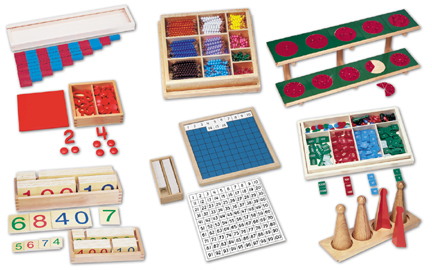
In Montessori Math, man-made mathematical concepts are tools used to build an understanding of the known universe and to explore the unknown. But, while Montessori is a scientifically proven approach to education and the Montessori maths progressions develop concrete concepts before moving to abstraction, it is a poor representation to confine it to this limited definition or separate the maths curriculum from other ‘curriculum’ areas.
The Montessori math program and materials were developed through observation and experimentation aligned with a comprehensive understanding of human development, encompassing the Four Planes of Development (Birth to six, six to twelve, twelve to eighteen and eighteen to twenty-four years), and the sensitivities (Sensitive Periods) that are unique to each plane. Sensitive periods occur when the child is especially sensitive to learning specific skills that they are pre-programmed to develop (such as walking, talking, and reading). It is the first two planes of development that are the most important, the first being the most crucial. From birth to six the child is a sensorial, hands-on explorer with an absorbent mind (0-3) and where the conscious mind is ‘born’ (3-6). The child is involved in constructing ‘self’ through developing practical life skills, competence, concentration, self-discipline, manipulation of materials and motivation through intrinsic satisfaction. Montessori math materials give them a concrete introduction to fundamental mathematical concepts and the logical reasoning underlying them in a way that supports this self-construction.
The prepared environment is one that allows the child to fully access materials suited to their needs and stage in a clean, tidy, beautiful and ordered environment. Equipment and materials are purposeful, child-friendly, child-sized, orderly, complete and always in the correct place.
The Didactic materials are scientifically developed and often have multiple purposes, such as the bead chains which build on one-to-one counting, then into skip counting and early multiplication concepts and can also be used to construct polygons. Later the bead chains become part of a decanomial study involving cubes and squaring. From her understanding of the hands as instruments of man’s intelligence, Maria Montessori created the hands on manipulatives to help construct then test a child’s understanding, evoke their imagination and aid their understanding of abstract ideas. While pure mathematics includes the study of patterns, structures and relationships, in Montessori education, the “things” become less important than the way and the why.
– Helen Ramsdale (Montessori Math and Cosmic Education)
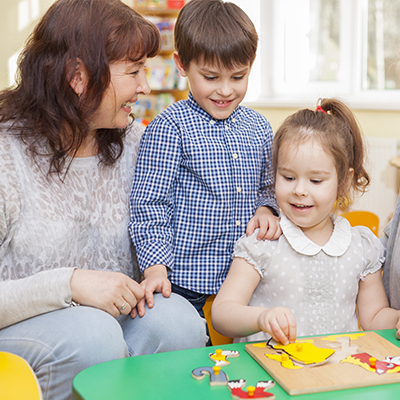
ART AND CREATIVITY
In addition to the above core components of our Montessori Program, we offer the following areas and activities:
- Geography
- Botany
- Anatomy
- Zology
- Science and Experiments
- Audio Visual Learning
- Entertainment
- Arts
- Crafts
- Music
- Sport
- Yoga
CONTACT US
Get In Touch
If you have any questions, feel free to send a message.
- Sherman Oaks/Encino, California
- 8:30 am - 5:00 pm
- (310) 465-3767
- info@mahamontessori.com

